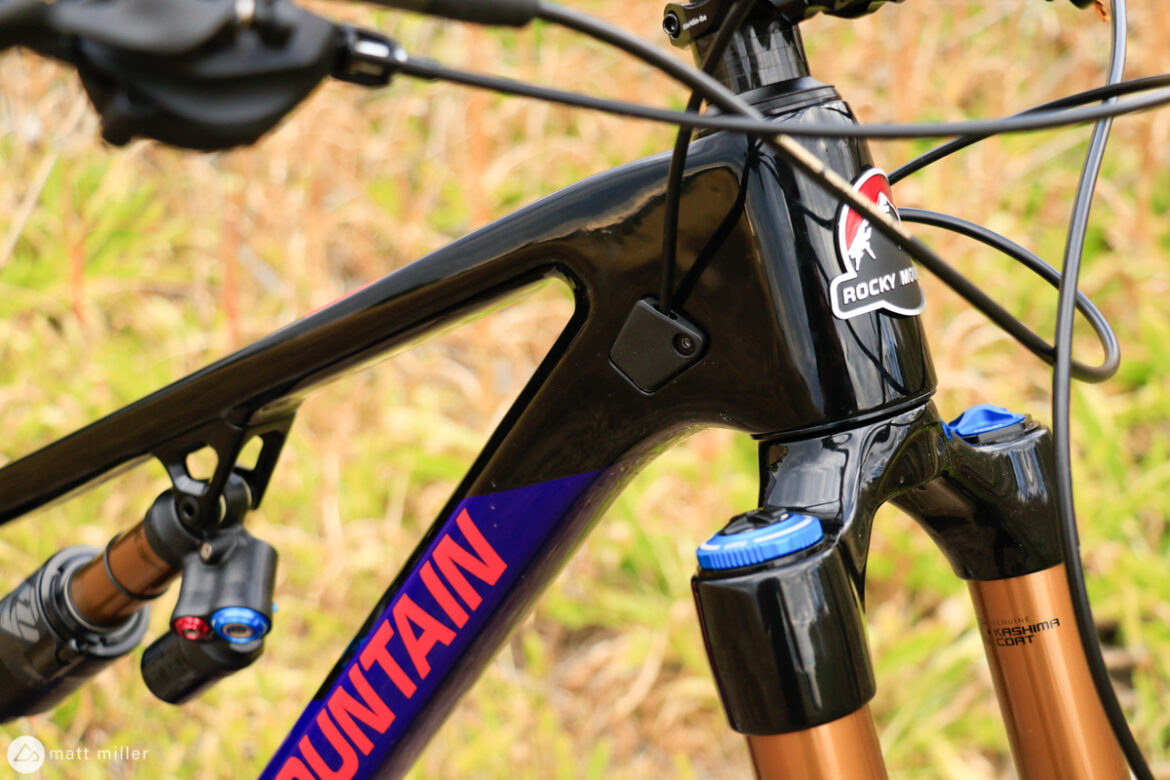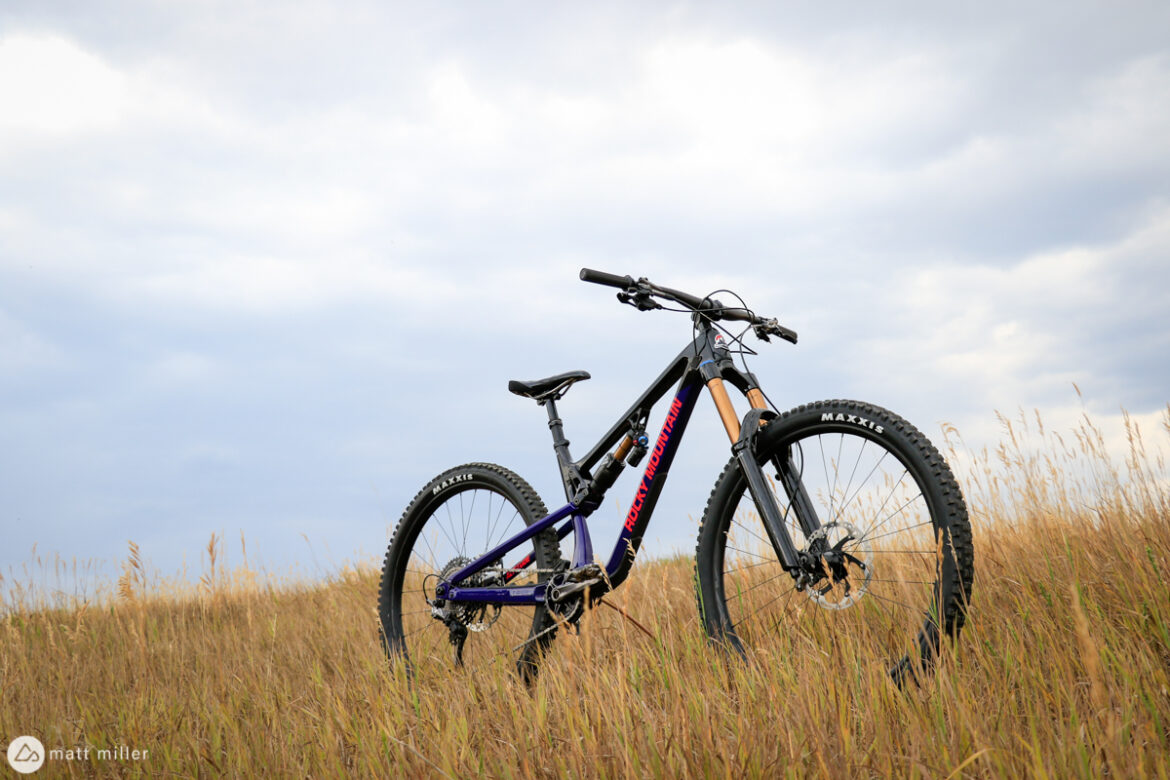
Editor’s note: Read our take on the latest Rocky Mountain Altitude.
Rocky Mountain revised their Altitude enduro bike and consolidated their lineup this summer, designating the newest version as the sole EWS-ready bike and doing away with the juiced-up BC edition of the Instinct trail bike.
The Altitude is now Rocky’s second biggest bike, at 170mm/160mm of travel front and rear. Sizes small and medium have a choice between 27.5-inch of 29-inch wheels and sizes large and extra large are only available as a 29er.
Rocky Mountain included typical elements like the Ride-9 adjustably geometry chip and added a few other details that are new, like an adjustable chain stay length, something we’re seeing more of on race-worthy bikes. Add some length between the rear wheel and the bottom bracket for fast, flat out races. Take some length away for the trails at home or for twistier, tighter courses.

The geometry isn’t the longest or slackest compared to other enduro bikes, but that might not matter. Jesse Melamed won an EWS title before the bike was released and it doesn’t feel like angles hold this bike back one bit.
In its neutral position on a size medium, the Altitude 29er has a 65° head tube angle, a 76° seat tube angle, the chainstays change between 437 and 447mm with a flip-chip, the reach is 455mm, and the wheelbase is 1217mm. Rocky made the Altitude to sit low, maximizing seat tube clearance and standover height. On the medium, the seat tube measures 420mm, and the standover is 816mm; it’s not the lowest, but they measure standover height about a third of the way up the top tube and numbers aside, the lengthy-limbed beast feels low to the ground. Overall, these angles aren’t far off from the 130mm travel GT Sensor trail bike I was riding around this same time last year, however the slackest Ride-9 setting can drop it by more than a half-degree.
The Altitude starts at $3,500 for a complete alloy A30 build, and it’s not a bad looking build with a Marzocchi Z1 Bomber fork, a Fox DPX2 shock, WTB wheels, and a Shimano Deore groupset. Yes, it’s 35lbs., but that does come with tubes, so there is potential to lighten up before pushing it out of the bike shop doors.
A full carbon frameset sells for $200 more than an alloy complete and there are seven other builds available after the A30, ranging from $4,300 to $10,000.

My test rig, a C90 Rally Edition, which is supposed to mimic what the Rocky Mountain/ Race Face EWS team rides, has a $9,100 price tag and an excellent choice of components. Build picks like the alloy Race Face Turbine R rims, the DoubleDown 3C Maxxis Minions, and 203mm brake rotors front and rear are all meant to inspire confidence in the rider and the bike’s durability. Some of the picks add weight, and even so, this Altitude weighs a very reasonable 32.3 pounds with tubes and without pedals.
The price on the Rally build is a bit of a deterrent though. Both the C50 (Discontinued) and the C70 ($7,000) are more attractive. Both should suit most riders who aren’t gleaning over every detail that will make them slightly faster. The C50 comes with the lighter Fox DPX2 shock, and still gets a Fox 36 up front, and a Shimano XT/SLX groupset with some money-saving details like a Rocky Mountain stem and bar, and a set of WTB rims. That build still comes in at a reported 31.5 pounds. Rarely do you get to spend less for a lighter bike.
On the trail

I was fortunate enough to receive the Altitude ahead of the release and spent about two months on the bike. Aside from the weather’s effects on our state’s wildfires, the fall has been exceptional for riding and I’ve had an extended season in the high country. I have been able to get this bike on some steep and chunky descents, where it belongs.
With the sticky Minion tires, the bike is no speed machine uphill, but the Altitude is a great climber considering its downhill capability. The suspension feels refined and efficient and the geometry is well-suited for a comfy position. There is minimal pedal bob from the saddle and the traction feels great over technical uphill puzzles. On more buff climbs, I moved the Fox X2 dial about a third of the way between open and firm but had no problem leaving it open most of the time.

The 76° seat tube angle makes for a roomy cockpit with a steep enough position for graded climbs but doesn’t feel cramped when you’re not trying to scale up a wall. In the steepest setting, the Altitude seat angle hits 76.5°, though the angles on many enduro bikes these days are starting to tilt much higher than that. While it can help on steep climbs, the uber-forward position doesn’t always feel best on more moderate trails or service road climbs. Somehow the Altitude’s geometry strikes a balance of being enduro-capable and spritely enough through skinny singletrack.
I didn’t need to change much about the stock bike for my preferences. I subtracted a point of low-speed compression from the fork, and two from the shock’s base tune to get a more floaty feeling over stretches of blocky rocks, as I felt a little hung up at first. That alone did the trick for me without the rear end feeling mushy under power.

If I could describe the Altitude’s descending skills with one word, it would be stable. While still not the longest bike, I’d also attribute the Altitude’s planted suspension feel to its stable nature. I swapped the chainstay setting from short to long for a ride. The Altitude gains some confidence, but it’s not as adept to maneuver through tight turns with the 447mm chainstays. During my time with the bike, I felt that it was stable enough for me in the short setting and preferred the handling in that setting.
One word I didn’t find with the Altitude is playful. Like I mentioned above, the bike feels planted and unshakable on descents, and while it’s of course possible to get the bike in the air, it prefers to be near the ground. Think of it as more of a turkey than a sparrow.


The Rally Edition build kit surely aids the Altitude’s trail-mashing capability, especially with the new Fox 38. The wider stanchions help with a responsive steering feel at the wheel and the fork feels as supple as ever. Perhaps with less stanchion flex, the travel through the fork feels even smoother and more sensitive. At 5’8″, and 165-170 pounds riding weight, a Fox 36 would suffice for me and keep the weight down, but the extra two millimeters are noticeable.

Rally build aside, the 203mm rotors are wonderful on the front and rear wheels matched with the snappy 4-piston Shimano XTR brakes and the drivetrain has worked great, as expected. There does seem to be room for a 170mm dropper post, instead of the 150mm on the medium, but it never got in my way. At $9,100, the Rally build also feels like carbon wheel territory, but since enduro racers often prefer alloy wheels, I can see why the brand specced the Turbine Rs instead of the Next R wheels.
The Vault hub is quick and reliable and even though I’ve smacked the rear wheel on a number of rocks, I haven’t had any flat tires with tubes in the wheels and no dents in the rim. Maybe it’s because of the thicker casings or some flex from the alloy wheels. Either way, it’s worked.
Closing thoughts

Rocky Mountain made some great moves with the consolidation of the Instinct BC and Altitude, and there’s no mistaking what their new enduro bike is out to accomplish. For riders who are after the fastest way down the mountain, the Altitude is an excellent choice.
Carbon bike builds available at JensonUSA



















